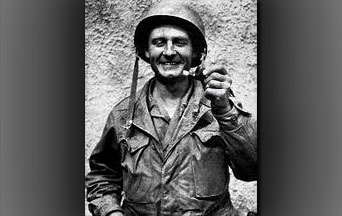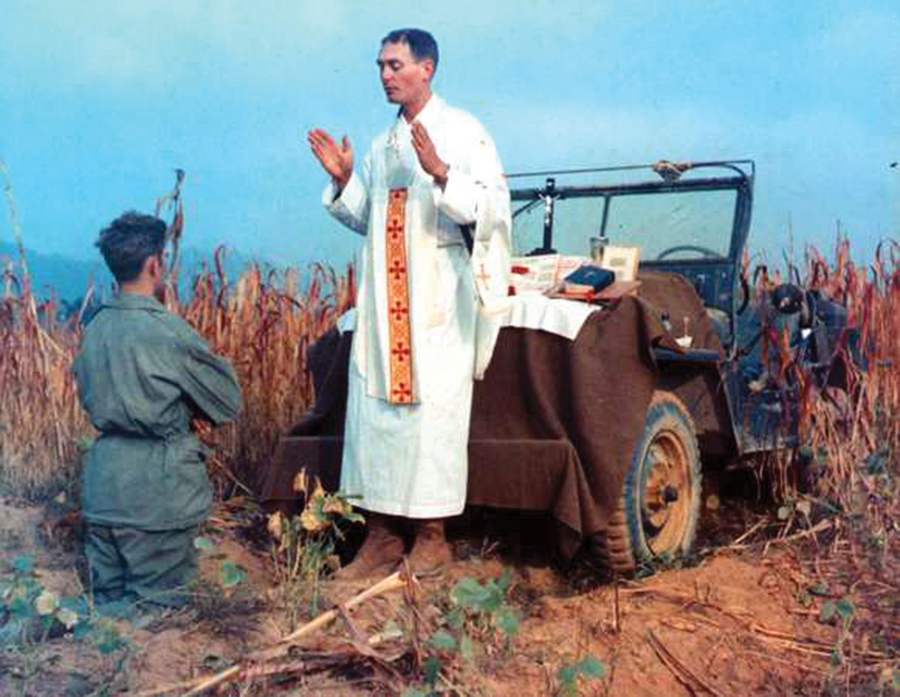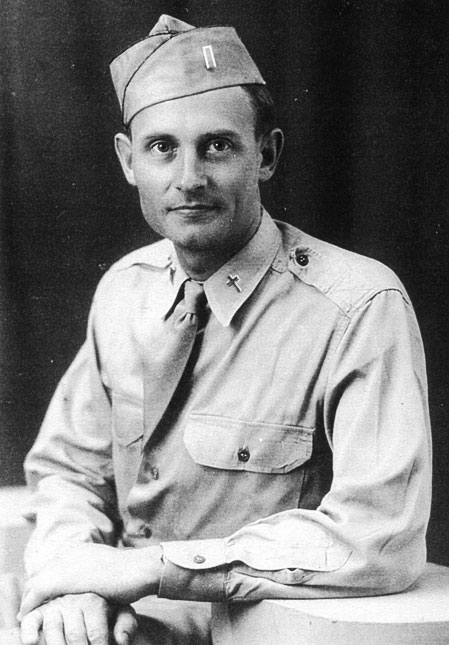
Imagine a photograph of a soldier. His uniform is incredibly rumpled. The straps of his grimy helmet are unfastened. A barely discernible cross painted on that helmet indicates he is a chaplain. In his right hand is the bowl of a broken pipe with the stem. The photographs’ caption explains that he was smoking the pipe when an enemy bullet struck it. The shot missed his head by an inch, and he wears the beaming smile of a man who has narrowly escaped death.
Unspeakable Conditions
On November 2, 1950, the North Korean Army captured this chaplain. On May 23, 1951, malnourished and unable to walk, Father Emil Kapaun died. His fellow prisoners buried him in an unmarked mass grave. The North Koreans turned over the remains in that grave to the United States in 1954. The Army re-interred them in Hawaii.

When his fellow prisoners returned home, they spoke of Father Kapaun’s courage, help and care for them. A website devoted to his memory relates what these prisoners thought of him. “He rallied his ‘boys’ to continue fighting to stay alive, both for themselves and each other. Although he was only with them for seven months, the surviving POWs testify that his selfless example was the inspiration they needed to keep each other alive during the next two and a half years of their imprisonment. One of Kapaun’s fellow prisoners of war sums it up well: ‘Father proved himself to be the greatest example of manhood that I’ve ever seen in my life.’”
Eternal and Natural Law: The Foundation of Morals and Law
Father Kapaun received the Congressional Medal of Honor for his selfless action. The citation describes his deeds and their consequences. “Once inside the dismal prison camps, Kapaun risked his life by sneaking around the camp after dark, foraging for food, caring for the sick, and encouraging his fellow Soldiers to sustain their faith and their humanity. On at least one occasion, he was brutally punished for his disobedience, being forced to sit outside in subzero weather without any garments. When the Chinese instituted a mandatory re-education program, Kapaun patiently and politely rejected every theory put forth by the instructors. Later, Kapaun openly flouted his captors by conducting a sunrise service on Easter morning, 1951.”

The Death of a Faithful Man
Eventually, a blood clot prevented Father Kapaun from walking. His captors then ordered that he be taken to a “death house,” where there was neither food, drink, nor care. The other prisoners tried to protect him. In a short film, fellow POW Mike Dowe related the last moments before Father was taken away.
“By then, I was crying. He said to me, ‘Mike, don’t cry on my behalf. I’m going where I always wanted to go, and when I get there, I’ll be saying a prayer for all of you.’”
After their release, Father Kapaun’s fellow prisoners started a memorial fund in his honor. The money was given to Wichita Bishop Mark Carroll. It became the “seed money” for the construction of Chaplain Kapaun Memorial High School. When the school opened on September 6, 1956, Bishop Carroll related the story.
 Learn All About the Prophecies of Our Lady of Good Success About Our Times
Learn All About the Prophecies of Our Lady of Good Success About Our Times
“The dream and wish of the heroic American soldiers in the cold and barren prisons of North Korea have been fulfilled beyond their fondest expectations. Chaplain Kapaun lives and will live in the walls of the new high school in Wichita. His love of God, his patriotism, his strong spirit of fraternity and helpfulness to his fellow men will, in due time, be the inspiration and spiritual dowry of the Kapaun graduates of the future.”
The Archdiocese of the Military opened a cause for Father Kapaun’s canonization in 1993, at which time he received the title “Servant of God.” The Diocese of Wichita took over the cause in 2008. It has collected over 8000 pages of documentation on his life. Although delayed by the coronavirus crisis, the cause continues.
An Unexpected Discovery
One issue that complicated his cause was the absence of physical remains. Many hoped that his body would be identified among those buried in Hawaii in 1954. However, there was no way to certify his set of remains were among them. All that was known was that he was buried somewhere along the Yalu River. The Wichita Eagle quoted Fr. John Holze, episcopal delegate for the office of Father Kapaun’s cause. “We had very little hope that we would ever have his remains.”
In March 2021, Army scientists announced that they used DNA testing to identify Father Kapaun’s remains.
Science Confirms: Angels Took the House of Our Lady of Nazareth to Loreto
Bishop Carl Kemme was delighted with the unexpected news. “It was a joyful and exciting surprise for the Diocese of Wichita that Father Kapaun’s mortal remains were recovered after so many years, and we continue to look forward to his process of canonization in the future.”
A Continuing Legacy
The Father Kapaun Guild maintains a website dedicated to these canonization hopes. His childhood parish, St. John Nepomucene in Pilsen, Kansas, operates a small museum dedicated to his memory. One artifact is a crucifix carved by his fellow POWs while still interred. It was constructed of scrap wood and carved with tools fashioned from steel parts of their combat boots.
Unlike so many other Catholic high schools, the one named after Father Kapaun is still open. Now known as “Kapaun Mt. Carmel,” the students pray a prayer, part of which is reproduced below:
We now ask you, Lord Jesus,
if it be your will,
to make known to all the world
the holiness of Chaplain Kapaun and the
glory of his complete sacrifice for you by
signs of miracles and peace.In your name, Lord, we ask,
for you are the source of peace.
the strength of our service to others,
and our final hope. AmenChaplain Kapaun, pray for us.

